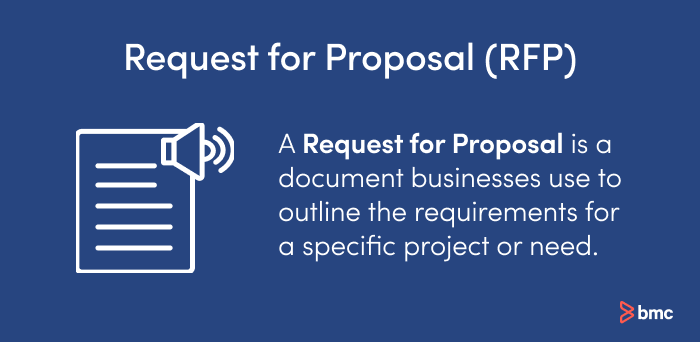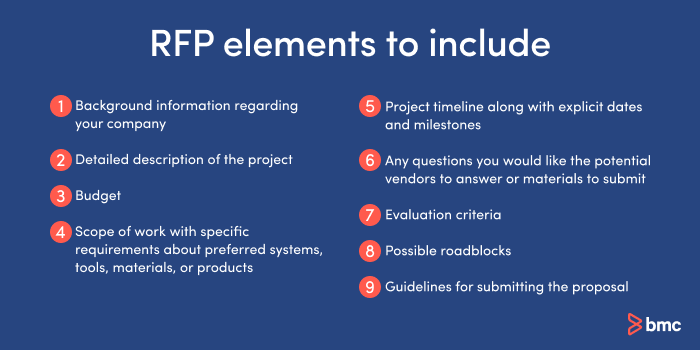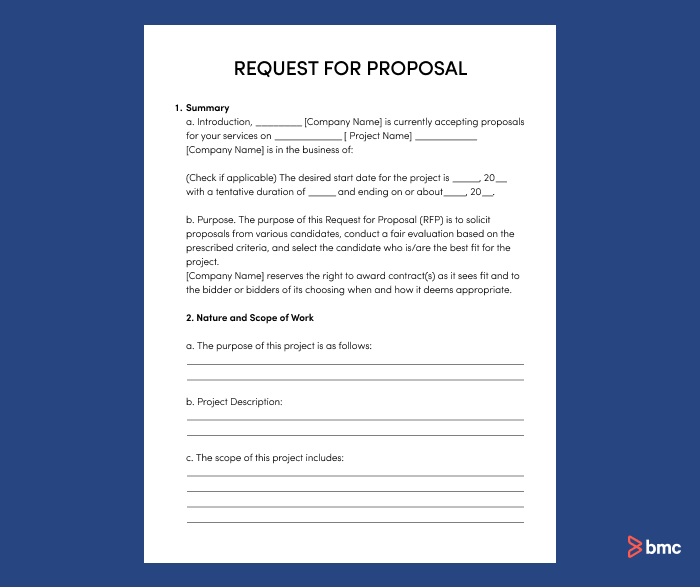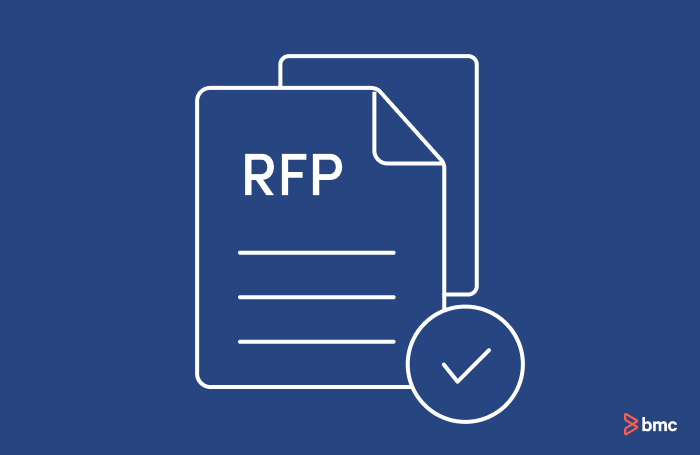No matter your industry, the time will come when you must submit a Request for Proposal—known simply as an RFP. At some point, your company must purchase a product or service from a third-party vendor. The RFP is a solicitation—you ask vendors whether and how they can solve your problem and support your project.
Although RFPs are a prevalent standard in the business world, they still lead to a lot of confusion for many. That’s why we’ve put together this guide on RFPs, complete with:
- RFP Definition
- Who requests RFPs
- Ways to decide if an RFP is necessary
- Benefits of RFPsv
- The 4-step RFP process
- What to include in an RFP
- RFP template
- Best practices for submitting proposals
- Additional resources
What is an RFP?

A request for proposal (RFP) is a document businesses use to outline the requirements for a specific project or need. Issuing an RFP is the process that an organization goes through to communicate a need for services. The RFP invites relevant vendors to submit proposals to meet the desired need. More specifically, the RFP is a document that explains a project’s needs and asks for proposed solutions from potential vendors.
A good RFP allows you to:
- Collect offers from different vendors so you can compare their skills and rates and choose the vendor that best meets your criteria.
- Outline your preferred scope and price, so potential vendors know how and what to bid to win the work.
- Quickly evaluate strengths and weaknesses of the bidding vendors without having to spend a lot of time researching each company yourself.
Issuing an RFP is a multi-step process that can be time-consuming and complex. However, because the RFP determines how your organization presents itself to many companies and professionals, it’s important that it’s well drafted and that the process is conducted professionally, accurately, and fairly—your reputation is on the line.
Who typically requests an RFP?
Many federal, state, and local government entities, along with educational institutions and utilities, are legally required to issue RFPs to maintain fair dealings without favoritism and transparently show that they got the right goods and services at a favorable price. Non-profit organizations also frequently use the RFP process to ensure the efficient use of donations. Corporations turn to RFPs for large and complex projects and when they don’t already have relationships with qualified vendors.
When should an RFP be required?
When to issue an RFP is up to you. Most often, you issue an RFP when you have a new need but you do not have the internal resources to meet that need. The RFP can be an effective way to connect with vendors, partners, consultants, or organizations that have the resources, skills, and expertise to meet that need.
However, issuing an RFP takes time and resources. It is crucial to first determine when it’s necessary to issue an RFP. Another method—for example, a request for quotation—might be a better course to take.
Here’s a rule of thumb for RFPs:
- For simple, straight-forward projects, an RFP might not be necessary (assuming there are no organizational policies or regulations that require it).
- RFPs are often beneficial and necessary for complex, specialized projects.
What is the difference between an RFI, RFQ and RFP?
RFsI, RFQs and RFPs all play a role in business procurement processes at different stages.
- An RFI or Request for Information may be issued early in the process so that an organization can understand the options, capabilities, and various vendors. The information gathered from RFI responses helps craft an RFP.
- An RFQ or Request for Quotation is a way for an organization to gather pricing information for various options across products, services, and solutions. It is useful for comparing prices and for determining budgets.
- An RFP or Request for Proposal in project management is a way to gather comprehensive information about products, services, scope of work, methodologies, timing, expertise, cost, and potential value-added components.
What are the benefits of an RFP?
Here are some benefits of RFPs that can be helpful in determining whether to issue one.
If you don’t have policies or regulations requiring an RFP in your project management or business, and you’re struggling to determine whether one is necessary, consider these factors in your analysis. Further, these benefits should be weighed against the time and resources required by the process. Conducting that analysis should help you determine whether it’s necessary or wise to issue an RFP. You might determine that an RFP isn’t a valuable use of resources.
1. Faster vendor selection
One of the most basic and common reasons businesses decide to issue an RFP is that they need to find a vendor to meet an organizational need. Sometimes, this is done because organizational policies or government regulations require it; other times, it’s simply because leaders determine that a request for proposal is the best way to find the resources or expertise to meet a pressing need.
2. Competition and equal opportunity for vendors
An RFP is an opportunity for potential vendors to compete head-to-head so that you can find an exceptional partner. The process brings you proposals from companies that are familiar as well as those that are unknown. With broad exposure, you can ensure you have the right match for a successful project.
3. Transparency and accountability
Another reason that organizations decide to issue an RFP is because of the accountability and transparency that the process offers.
When done correctly, a request for proposal encourages fairness in the process of selecting vendors while providing important transparency about what vendor was selected and why. This can be an effective way to reduce issues associated with favoritism and corruption. Finally, it inherently offers needed accountability to those individuals tasked with selecting vendors while establishing practices of good governance.
4. More clarity and alignment
A less common but equally important reason for issuing an RFP: the process of drafting and issuing the request can help you better understand your own project, including the components to complete it successfully.
Simply the act of drafting an RFP leads to a better understanding of what your specific needs are. This helps to ensure that these needs are met and that the project is successful.
Steps in the RFP process
Once your organization has decided to issue an RFP, it’s time to begin the multi-step RFP process. When putting together your own RFP or bidding on another organization’s RFP, you’ll hear a lot about “the RFP process”.
Although every organization has their own method of doing things, you can typically expect that the RFP process will follow these four steps:

Let’s look at each step.
1. Discovery
Before drafting a request, it’s important to do some thorough internal planning to help make the process efficient and effective. The first step of the RFP process is to go through a discovery phase with key stakeholders. You’re trying to discover three key things:
- What would go into creating the RFP. Establish project boundaries, develop a realistic timeline, and include an estimated budget.
- Who will manage and execute the RFP process. These individuals should have both the organizational knowledge and project-specific knowledge needed to draft a detailed RFP and to adequately evaluate submitted proposals.
- What could be affected by the purchasing decision. This one is more open-ended, but consider how the decision might affect ongoing projects, your organizational budget, and even your relationships with internal teams and other third-party vendors.
In this meeting, talk about broad business goals that could be met with this project and what your estimated budget would be. You will also need to decide on how you will evaluate different bidders and what categories are a top priority for your needs, such as security, speed to implementation, project functionality, etc.
2. Draft and issue RFP
Next up is the actual drafting of the RFP document. Drafting the RFP is the most important part of the process, as a well-drafted RFP is necessary to accurately describe the issues that need to be addressed. The more thorough the document is, the better, as this will enable prospective vendors to understand the problem more comprehensively while more effectively offering solutions.
Look at a variety of RFP samples to ensure everyone understands what the finished product will look like. Then, search out template ideas that can help you start drafting. The easiest way to start a strong draft? Choose a template foundation that includes most or all of the categories you want to cover in your document.
Experts assert that a well-drafted RFP document should include:
- The purpose of the RFP
- A clear description of project goals and results
- A rubric or criteria that will be used to evaluate submitted proposals
- A “wish list.” Some experts argue that in addition to including the non-negotiable aspects of a project, it’s helpful to include a list of things that your organization would like to see included in a proposal or throughout the project.
- A timeline for the project including a proposal deadline, an evaluation window, a selection date, a date to notify vendors that were not selected, and a completion date for the entire project.
To help guide your organization through the process and ensure that all essential components are included, it can be helpful to start with an RFP template (we provide a free one further down in this article). Keep reading to find out how to make this process as easy as possible, including tips and advice on how to write an effective RFP and ways to prepare it more effectively.
With the template and draft decided, develop the RFP scoring criteria, which could be a rubric or scoring matrix. An easy way to do this is using a weighted number range between 1 and 10 that helps you quantify categories based on importance. For instance, this matrix could be as simple as three columns:
- Requirements listed
- Scores
- Weight of the requirement
Using your chosen request for proposal template, fill in the factual information first—like business or project history, budget, etc. Then add in the other more complex sections as you decide them. Have multiple team members working on and editing the draft together, ensuring that the wording makes sense and it is stated in the clearest way possible.
Set clear timelines and submission instructions, and then issue the RFP publicly. Be thoughtful and strategic about where to share the RFP based on the vendors with whom you want to connect. After determining what type of vendors you want to reach—based on industry, location, organization type, and other relevant factors—there are a number of resources, that can help to ensure that you share your request for proposal in such a way that you connect with the right vendors. (Most industries have one or several standard venues for posting an RFP.)
3. Score and shortlist proposals
As you receive responses, use your scoring matrix to begin evaluating vendors, eliminating those that don’t meet your non-negotiables. Begin to identify strong points among vendors, and shortlist those that have the highest scores.
Be sure to clarify any questions that might come up from vendors during the submission window. Once the submission window closes, however, you do not need to respond to vendors until you’ve made your decision.
4. Select the winner and send the contract
Once the response window closes, compare your shortlisted vendors in order to make a decision. Check all their contact references and reviews, ensuring that you see consistency between what they shared and what their other clients say. Reach out to vendors if you think additional meetings or materials will help in choosing.
Once you narrow it down to two or more leading bidders, negotiate between them, locking in a price and contract with your final choice.
In the end, take time to notify the non-winners and let them know why you decided not to go with their product or service.
What should you include in an RFP?

Most RFP templates include similar categories of information, but some of these might change depending on the goals of a project or your company’s needs. Some typical categories to include in an RFP document are:
- Background information regarding your company
- Detailed description of the project
- Budget
- Scope of work with specific requirements about preferred systems, tools, materials, or products
- Project timeline along with explicit dates and milestones
- Any questions you would like the potential vendors to answer or materials to submit
- Evaluation criteria
- Possible roadblocks
- Guidelines for submitting the proposal
1. Company introduction
In your RFP introduction, include any background information regarding your company and its history that you feel might be important for potential contractors to understand, including:
- When the organization was founded and by whom
- Locations
- What types of services or products you offer
- What makes you different from your competitors
It’s best to keep it short and sweet to give vendors a general idea of who your company is and who you serve.
2. Project overview
One of the most important parts of writing an RFP is the actual description of the project itself and its goals. Make this section highly detailed so vendors know exactly what you are looking for and if they can meet those needs. Remember—the more specific you can be, the better quality of your received bids. Outline what you would consider to be contract-winning services.
RFP project overview should include the following:
- All the business goals you expect to accomplish from the project
- An outline of any individual criteria or tasks that could be necessary
3. Budget
Be upfront with your budget so contractors can get an idea of what you can spend. They will be able to put together an approach and components that meet your needs while staying within your spending limits.
4. Scope of work
If you are looking for extremely specific systems, tools, materials, or products, you must include some type of checklist, so vendors know what you are hoping and expecting to receive.
The RFP is your document, so in scope of work, you can put in it exactly what you need.
5. Timeline
By including a detailed proposal timeline in your RFP, you can automatically eliminate any vendor that can’t meet those deadlines and milestones, saving you (and them) some major headaches along the way. Should you have some flexibility with your project, you can mention that in the proposal, stating that you are open for negotiation with the right candidate.
Having a mapped-out schedule of the project deadline and any necessary milestones ensures that the project moves along at the pace you are intending. It also reduces the chance of work not being completed. Vendors need to quickly know your RFP requirements—so they can determine if they have the bandwidth and resources to get the project completed on time.
6. Questions or materials
This is a great section to include. Create a list of materials that you would like the potential vendor to supply, including things like:
- Their proposed cost of services
- Samples of past work
- Proof of technical skills to complete your project
- Proven success with other similar companies or projects.
You can also use this section to ask specific questions that you’d expect vendors to answer in their submitted RFP documents.
7. Evaluation criteria
Evaluation criteria are the criteria that matter most to your goals and project that you decided on in your discovery phase team meeting. By sharing this with your bidders, they will be able to understand exactly how they are being scored—and know how they might fare ahead of time.
If you decide to utilize weighted scoring, it will also be crucial to include this. For example, your RFP weighted scoring might be:
- 30% of your decision is based on cost estimate
- 35% on technical requirements
- 10% on approach
- 15% on management
- 10% on innovation
8. Possible roadblocks
Possible roadblocks allow you to eliminate bidders that couldn’t work and help you determine what vendors have the necessary expertise to tackle potential challenges. Just like you expect contractors to be upfront with you about their prices and abilities, you must also give them a heads-up should any roadblocks potentially delay things or even prevent certain vendors from being able to complete the project.
Although RFP roadblocks will vary greatly depending on industry and company, things like outdated plan forms, custom coding, and limited resources are just a few examples of what you—and your contracted vendor—might have to deal with.
9. RFP guidelines
This final RFP submission requirements section will tell candidates a lot of important details, like:
- Where they can access the RFP
- When the RFP can be accessed or downloaded it can be accessed
- How many copies they should include
- Who they should submit it to
- How it should be marked
- The final deadline for receiving RFPs
Free RFP template
Sourcing a free request for a proposal template doesn’t have to be complicated—and neither does your actual RFP. This will certainly depend on what type of product or services you need.
This is a good basis for a general RFP template:

Vendors submitting RFPs
How do you submit a proposal?
Best practices for vendors who submit RFPs include:
- Identify a team lead to own the RFP submission process
- Follow the directions as closely as possible
- Use your lessons learned from past RFP submissions—both those that were successful and those that didn’t win
- Include examples of your previous work, like a resume or CV for your company
- Put your competitive knowledge to work, predicting what other vendors might bid in terms of cost, timeline, potential challenges, and more
- Highlight your past successes through stories and customer testimonials
- Develop an in-house RFP standard, especially if you answer RFPs frequently
- Don’t wait till the last minute, as submitting RFPs has a way of becoming more complicated as you work on them
RFPs for enterprises
The complex requirements of an enterprise mean that you need to ask for more from potential vendors, to get detailed answers in written form, to have the ability to compare options, and for many people in your organization to weigh in on the decision. The RFP process is ideal in addressing those needs. Issuing an RFP in an enterprise business can feel overwhelming, but you have a multitude of resources that can guide you through it. Use those resources and the process will be as seamless as possible, ensuring project success.
Additional resources
For more on business best practices, explore the BMC Business of IT Blog and check out these articles:
- What is an IT Vendor Management Office (VMO)?
- How To Build Your ITSM Business Case (Free Template Included)
- The State of ITSM in 2020
- Cost Management Guide
These postings are my own and do not necessarily represent BMC's position, strategies, or opinion.
See an error or have a suggestion? Please let us know by emailing blogs@bmc.com.






